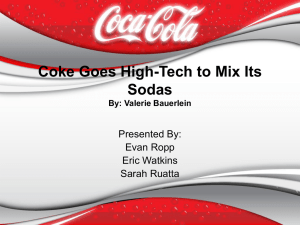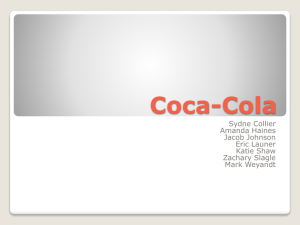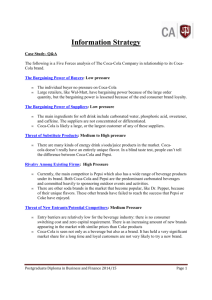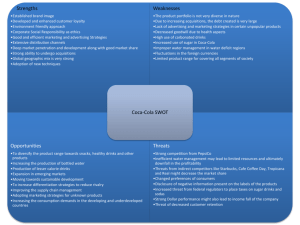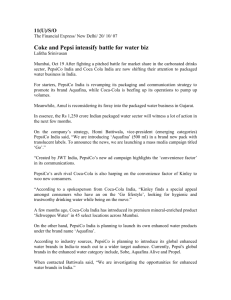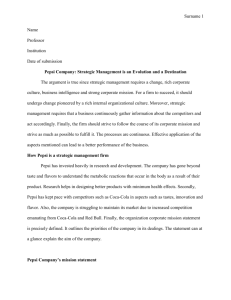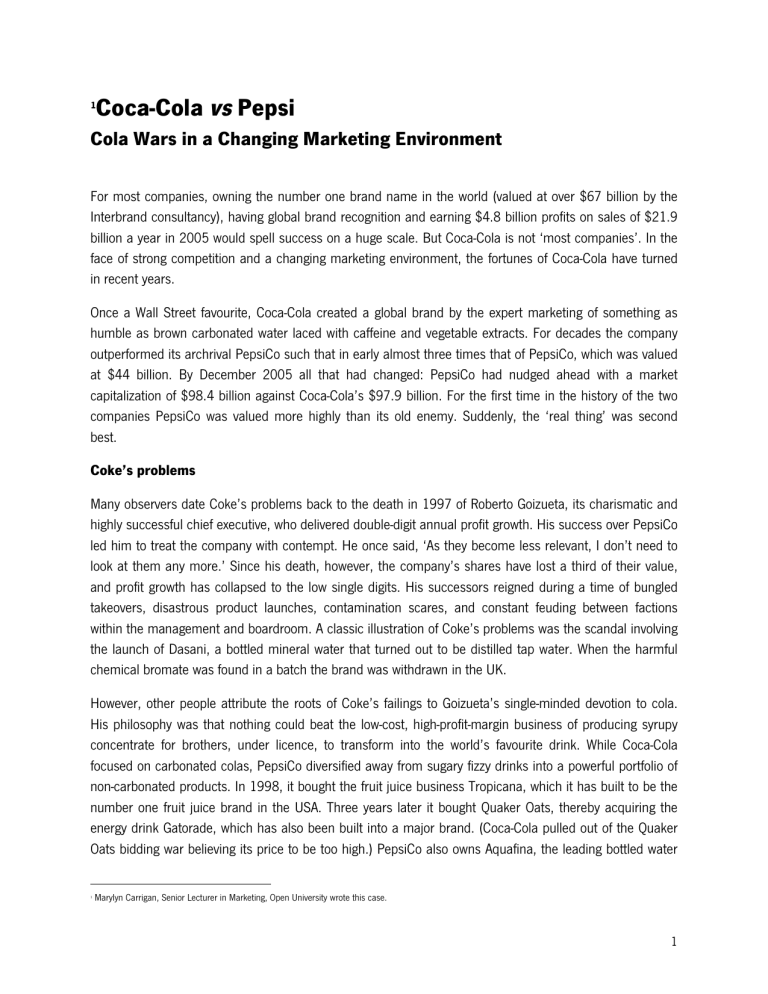
1 Coca-Cola vs Pepsi Cola Wars in a Changing Marketing Environment For most companies, owning the number one brand name in the world (valued at over $67 billion by the Interbrand consultancy), having global brand recognition and earning $4.8 billion profits on sales of $21.9 billion a year in 2005 would spell success on a huge scale. But Coca-Cola is not ‘most companies’. In the face of strong competition and a changing marketing environment, the fortunes of Coca-Cola have turned in recent years. Once a Wall Street favourite, Coca-Cola created a global brand by the expert marketing of something as humble as brown carbonated water laced with caffeine and vegetable extracts. For decades the company outperformed its archrival PepsiCo such that in early almost three times that of PepsiCo, which was valued at $44 billion. By December 2005 all that had changed: PepsiCo had nudged ahead with a market capitalization of $98.4 billion against Coca-Cola’s $97.9 billion. For the first time in the history of the two companies PepsiCo was valued more highly than its old enemy. Suddenly, the ‘real thing’ was second best. Coke’s problems Many observers date Coke’s problems back to the death in 1997 of Roberto Goizueta, its charismatic and highly successful chief executive, who delivered double-digit annual profit growth. His success over PepsiCo led him to treat the company with contempt. He once said, ‘As they become less relevant, I don’t need to look at them any more.’ Since his death, however, the company’s shares have lost a third of their value, and profit growth has collapsed to the low single digits. His successors reigned during a time of bungled takeovers, disastrous product launches, contamination scares, and constant feuding between factions within the management and boardroom. A classic illustration of Coke’s problems was the scandal involving the launch of Dasani, a bottled mineral water that turned out to be distilled tap water. When the harmful chemical bromate was found in a batch the brand was withdrawn in the UK. However, other people attribute the roots of Coke’s failings to Goizueta’s single-minded devotion to cola. His philosophy was that nothing could beat the low-cost, high-profit-margin business of producing syrupy concentrate for brothers, under licence, to transform into the world’s favourite drink. While Coca-Cola focused on carbonated colas, PepsiCo diversified away from sugary fizzy drinks into a powerful portfolio of non-carbonated products. In 1998, it bought the fruit juice business Tropicana, which it has built to be the number one fruit juice brand in the USA. Three years later it bought Quaker Oats, thereby acquiring the energy drink Gatorade, which has also been built into a major brand. (Coca-Cola pulled out of the Quaker Oats bidding war believing its price to be too high.) PepsiCo also owns Aquafina, the leading bottled water 1 Marylyn Carrigan, Senior Lecturer in Marketing, Open University wrote this case. 1 brand in the USA. The fruit juice, energy drink and bottled water sectors have all experienced double-digit growth in recent years. It has continued its acquisition programme with the purchase of the South Beach Beverage Co, which manufacturers the SoBe healthy drinking range, and has launched SoBe Life Water, which it claims contains the full recommended daily amount of vitamin C together with vitamins E and B, and no preservatives or artificial flavourings. Its bottling partner Pepsi-Americas has also bought Ardea Beverages, which markets the Nutrisoda range containing amino acids, vitamins, CoQ10, herbs and minerals. In contrast to Coke, the culture at PepsiCo was reported to be more dynamic and customer focused, and less bureaucratic. Where Coke has focused on soft drinks Pepsi has interests in the snack food business (it bought the FritoLay snack food business in 1965), owning such brands as Doritos, Walkers Crisps, Quavers, Lay’s Potato Crisps and Wotsits (see Table 1). The result is that PepsiCo generates about 23 per cent of its worldwide profits from the stagnant carbonated drinks sector, while Coca-Cola relies on fizzy drinks for 80 per cent of profits. Coca-Cola always seems to be playing catch-up, having launched Minute Maid fruit juice to challenge Tropicana, Dasani to take on Aquafina, and Powerade, an energy drink, following the success of Red Bull and Gatorade in this sector. Table 1 Cola wars: who owns what Coca-Cola brands PepsiCo brands Coca-Cola Pepsi Coke Zero Diet Pepsi Diet Coke Gatorade Powerade Tropicana Minute Maid Aquafina Dasani Lipton Iced Tea Fanta Frappuccino Lilt Mountain Dew Sprite Walkers crisps Calypso Lay’s potato crisps Oasis Quaker Oats Just Juice Quavers Kia Ora Doritos Five Alive Wotsits Malvern water Sugar Puffs 7-Up PepsiCo’s diversification programme and its brand-building expertise has made it the world’s fourth largest food and beverage company, ranking behind Nestlé, Kraft and Unilever. Its sales were more than $43 billion compared with Coke’s $32 billion in 2008; it has 16 brands that each generate more than $1 billion of annual revenue; and it owns 6 of the 15 top-selling food and drink brands in US supermarkets – more 2 than any other company, including Coke which has two. Coke, on the other hand, is market leader in carbonated drinks (43 per cent versus 32 per cent). Life since Mr Goizueta has also seen Coke criticized for its fall in marketing investments, including advertising and marketing research, in an effort to maintain short-term profits, and the lack of iconic brandbuilding advertising. Its culture has also been questioned and its high-rise headquarters in central Atlanta is known in the industry as ‘the Kremlin’ because of the political intrigue and bureaucratic culture that pervades its corridors. A new era? In response to its problems, Coca-Cola brought an ex-employee, Neville Isdell, out of retirement to become chairman and chief executive in 2004. One of his first acts was to allocate an additional $400 million a year to marketing and innovation. This was in recognition of the under-investment in brands and product development. Emerging markets such as China and India are also being targeted more aggressively. He also briefed advertising agencies around the world in an attempt to create new iconic campaigns to revive the core brand and reconnect with consumers. In the face of research that showed the proportion of Americans agreeing that cola is ‘liked by everyone’ failing from 56 per cent in 2003 to 44 per cent in 2005, and those agreeing that the drink was ‘too fattening’ increasing from 48 per cent to 59 per cent, Coke has increased investment in sugar-free brands such as Diet Coke and Sprite Zero. Sugar-free colas have also been launched, such as Coke Zero, which comes in black cans and bottles and is targeted at calorie-conscious young males who have failed to connect with Diet Coke, believing that it lacks a masculine image. The brand is designed to compete with PepsiMax, which is also a diet cola targeted at men. Overall, marketing spend for the category has doubled. Isdell has also overseen the acquisition of a number of small water and fruit juice companies in Europe. Isdell resisted the temptation to follow Pepsi with the acquisition of a snacks company. Instead his strategy was to focus on building a portfolio of branded drinks. Following this strategy, Coca-Cola has purchased the US firm Energy Brands, which owns Glaceau, a vitamin-enhanced water brand, and has bought a stake of between 10 and 20 per cent of Innocent, the market leader (68 per cent) of fruit smoothie drinks in the UK. Innocent has built a reputation for making only natural healthy products, and using only socially and environmentally aware products. At the time of the deal (2009), Innocent operated in the UK, Ireland, France, Scandinavia, Germany and Austria. Coca-Cola has also launched an energy drink, Relentless, aimed at men aged 18-40. Meanwhile, PepsiCo has introduced its own labelling system in the USA to identify healthier products, using criteria set by an independent board of health experts. Now 40 per cent of sales derive from products with the green ‘Smart spot’ given to healthier brands such as sugar-free colas and baked rather than fried crisps. Most of its research and development is focused on healthier products such as Tropicana-branded fruit bars, which provide the nutritional equivalent to fresh fruit. Sales of Smart Spot products are growing at twice the rate of those without the designation, and account for over half of Pepsi’s product portfolio. 3 Continuing its focus on healthy drinks, PepsiCo has launched Pepsi Raw, a premium cola, on to the UK market. The product, which uses cane sugar rather than high-fructose corn syrup, and no artificial preservatives, colours or flavourings, was positioned as the first ‘natural’ cola. Pepsi has followed its launch with the creation of PurVia, which uses stevia (a South American herb used to create natural sugar substitutes) as zero-calorie sweetener. It was first used in flavours in PepsiCo’s water brand SoBe Life. Coca-Cola followed this launch with its own equivalent, Truvia. The company has also launched Pepsi Extra Cold, which is sold in pubs and bars, so that consumers can be guaranteed a cool drink of draught Pepsi. Both companies have also attempted to arrest the decline in the carbonated soft drinks sector by launching a flurry of new products such as lime- and cherry-flavoured colas. Nevertheless colas have come under attack for their contribution to obesity. One UK school removed Coca-Cola fizzy drinks from its vending machines when it identified that its pupils were drinking on average three cans a day – equivalent to more than one and a half times a child’s recommended daily sugar intake. In the United States, Arnold Schwarzenegger (of Terminator frame), now governor of California, recently passed legislation banning the sale of all carbonated drinks in schools across California. Other ethical controversies have been encroaching upon Coca-Cola’s global hold on the drinks market. A French entrepreneur, Tawfik Mathlouthi, launched concern at American foreign policy and anti-American sentiment around the world. His aim is to encourage Muslims to choose Mecca-Cola rather than CocaCola. Coca-Cola, like other American brands, has felt the negative impact of US boycotts and antiglobalization sentiments targeted at US brands. Mecca-Cola has already been launched in France, Britain, Germany, Belgium, Italy, Spain and Scandinavia. Another alternative to US colas is ZamZam Cola (an Iranian brand), which is selling well in Iraq, Saudi Arabia, Pakistan and Africa. Under Mr Isdell, Coca-Cola achieved steady international sales and profit growth. In 2008 he returned to retirement and was succeeded by Muhtar Kent. Questions 1. Compare Coca-Cola’s response to the changing marketing environment before the arrival of Neville Isdell to that of PepsiCo. 2. Assess both companies in terms of their level of marketing orientation. 3. What advantages, if any, does PepsiCo’s greater diversification give the company over Coca-Cola? 4. What future challenges is Coca-Cola likely to face? 4
